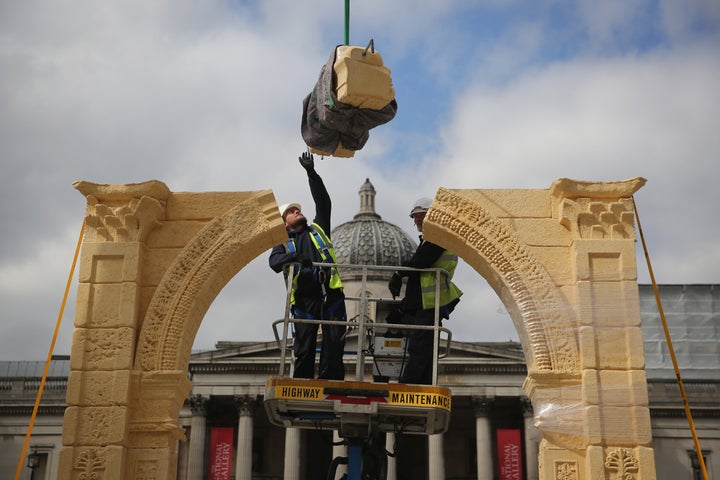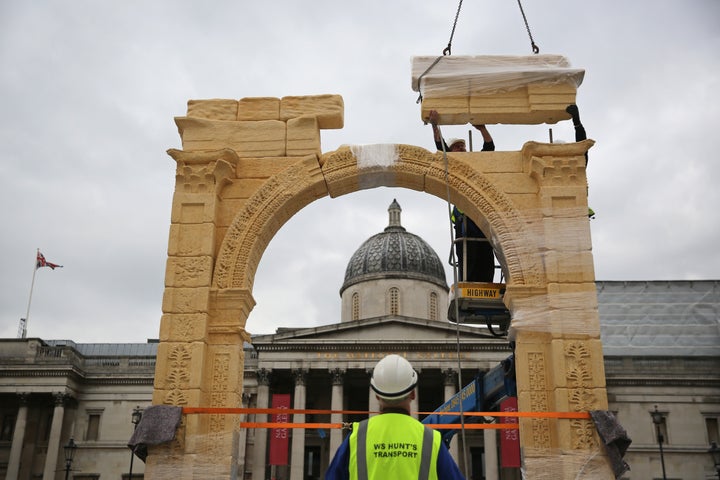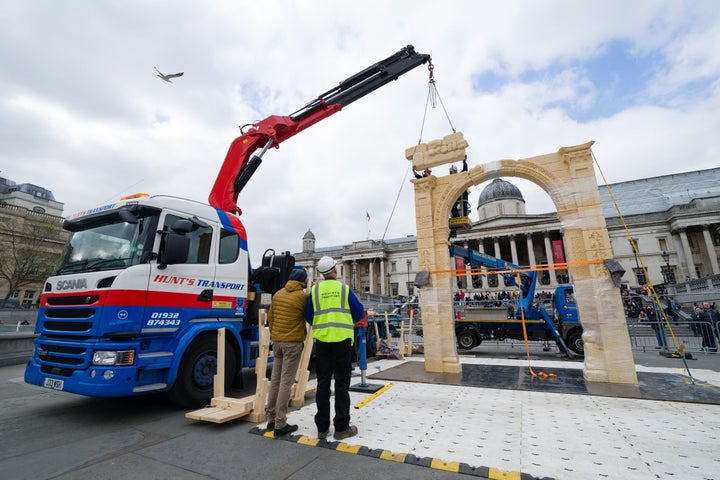A replica of the Arch of Triumph, the 2,000-year-old Syrian monument destroyed by the so-called Islamic State, has been erected in London's Trafalgar Square.
The two-thirds scale model was made from Egyptian marble using 3D technology, based on photographs of the original arch which was obliterated in October 2015.
Machines carved the stone to the exact shape and design of the original, which was built by the Romans. It is 5.5m high.
The replica will be on display for three days before moving to other locations, including New York and Dubai. Next year it is expected to find a final home in Palmyra, near the original arch.

Syria's director of antiquities, Maamoun Abdulkarim, has said the creation of the arch, by the Institute of Digital Archaeology (IDA), was an "action of solidarity".
"It is a message of raising awareness in the world," Abulkarim, who was in London to watch the replica being installed, told the BBC.
"We have common heritage. Our heritage is universal - it is not just for Syrian people."
Islamic State captured Palmyra in May last year and are said to have killed at least 280 people during their occupation. The area was recaptured from the terrorist group last month.

Abdulkarim, who visited Palmyra a week after its liberation, told the broadcaster that about 80% of the ancient monuments remain.
He said the purpose of the recreation project was to rebuild ancient monuments, rather than to create them afresh, saying "we can never have the same image as before Isis".
"But what we want to do is respect the scientific method and the identity of Palmyra as a historic site," Abulkarim said.
After Palmyra was attacked, Roger Michel, the executive director of IDA, said he decided the institute's Million Images Database project - which distributes 3D cameras to volunteers in countries including Syria, Afghanistan and Iraq - could take action.
"It is extraordinary to have a vision about something and see it come together in such a palpable way," the BBC quoted him as saying.

On the IDA website he wrote of the arch project: "We view the work of reconstruction as an important gesture of friendship and solidarity with people in the conflict regions - people with whom we share a common history, a history that is represented by the very artifacts and monuments we seek to protect and preserve."
Michel told the BBC he wanted London to be the first to house the replica because the city itself had been reconstructed after the Second World War.
Professor Bill Finlayson, of the Council for British Research in the Levant, which supports research into the archaeology of the region, expressed some concerns about the project to the BBC.
He said: "The publicity and so on is great. I have no problem with this [project].
"I think there is a bit more of a problem with the issue of reconstruction on the site itself.

"The dangerous precedent suggests that if you destroy something, you can rebuild it and it has the same authenticity as the original."
The installation of the replica, which cost about £100,000 to create, has taken place during World Heritage Week.
Coinciding with the installation of the arch is The Missing: Rebuilding the Past, an exhibition claiming to be the first to "showcase the efforts of artists and scholars who resist the destruction of cultural heritage" carried out by IS.
The IDA website said the institute seeks to provide an "optimistic and constructive response to the ongoing threats to history and heritage that have captured headlines over the past year".
"Our aim is to highlight the potential for the triumph of human ingenuity over violence by offering innovative, technology-driven options for the stewardship of objects and architecture from our shared past."
It continued: "Finally, we hope to raise awareness of the human cost of lost heritage and enlist a new generation of scholars, students and volunteers to assist in efforts aimed at historical preservation and study."
